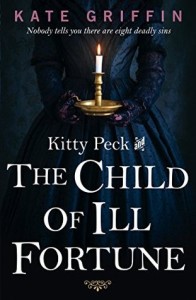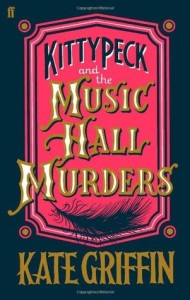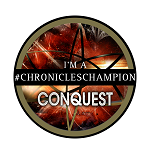Really pleased to welcome Kate Griffin to the blog today to talk about Kitty Peck, I threw a few questions at her and this is what she had to tell me. Some fascinating insight. I’m currently reading the first in this series having finished the brilliant Child of Ill Fortune very recently – yes I know I’m going backwards but sometimes I forget myself in this bookish madness – so look out for another feature on these coming soon when I shall review both. For now over to Kate to tell us more about the background…
Tell us a little about the original inspiration behind the Kitty Peck stories.
I think there are probably two main inspirations for Kitty Peck: family and film
My mother’s family lived in Limehouse in the second half of the nineteenth century and I’m very aware that the stories told by my grandmother, Hannah Beck, in particular have percolated into Kitty’s world.
Born in 1898, Hannah lived near the infamous Narrow Street. It always comes as a jolt to think that Jack the Ripper was stalking the streets of Whitechapel just ten years before my grandmother was born.
In the late nineteenth century London was the greatest and most cosmopolitan city in the world and Hannah’s childhood reflected that. Neighbours included Jewish refugees from Eastern Europe and Chinese immigrants. The distinctive clothing, language and appearance of the latter were a source for the thrilling, but distinctly non multicultural, works of writers like Sax Rohmer and even Conan Doyle.
I have no delusions of grandeur about my Limehouse ancestors. They were mostly immigrants themselves (from the Irish Potato Famine) and they were poor. There were, however, tight knit and hard working.
Life must have been hard, but like hundreds of others they found distractions and entertainment in London’s music halls.
My grandmother told me that at the age of twelve, for a penny, she was allowed into the galleries where she watched performers including Marie Lloyd, Albert Chevalier and male impersonator Vesta Tilley.
To an extent I’ve tried to reflect that vibrant cultural mix, but I’ve had great fun subverting the casual racism and sexual stereotypes of the original ‘Penny Dreadful’ style stories of the period.
The second inspiration is definitely my love of a peculiarly British sort of film. People have said that they find it easy to visualise Kitty’s world. I suspect the ‘scenes’ I write owe a great deal to the miraculous lighting and set dressing of classic Gainsborough Pictures films of the 1940s and even Hammer (greatly underrated in my opinion). All those hours I spent as a teenager watching those intense – and intensely beautiful – gothic tales on TV have left a mark on my writing.
I am completely unashamed to admit that in Kitty Peck and the Child of Ill Fortune I am playing with the rules of melodrama and loving it. In fact, I think melodrama is long overdue for a reboot and revival!
Is the Victorian era a period of time you find particularly fascinating?
Going back to my previous answer, I think it’s an era with an incredibly strong and exciting visual identity. In my imagination – and probably everyone else’s – it’s a period of swirling fogs, steam trains, galloping hackney carriages, cane-twirling toffs, veiled mediums and cloaked villains.
And really, what’s not to like about all that?
Scratch that completely artificial surface and you find an age of extreme, warring contrasts – old and new, tradition and discovery, truth and hypocrisy, wealth and poverty.
If you look at the engineering and architecture of the period you see a confidence that probably isn’t around today. I think the Victorians – the powerful ones – believed they could do anything, and they did, no matter the cost.
You only have to read Dickens (Night Walks) and Mayhew (London Labour and the London Poor) to understand how the majority really lived and the heavy price paid for progress and Empire.
The Victorian era is beguiling, but also deeply troubling. And that makes it a fascinating setting.
The novel is quite dark in tone, bleak but beautiful, as a writer how difficult is it to walk the line between entertaining and authentic?
Thank you for describing it as ‘bleak, but beautiful’. I think my own imagined Victorian world is exactly that.
Those who know me well seem quite surprised by the novel. I am generally quite an optimistic person – I can be annoyingly chirpy, to be honest – but as I soon as I start to write it’s the dark places that fascinate and attract me, both in terms of setting and character.
Although I’ve consciously created an elaborate and heightened world, I try hard to make it live for the reader by giving a clear sense of how things, taste, smell and feel as well as describing sights and sounds. Hopefully, no matter how bizarre or unnerving the situation, readers will go with me because, in that moment, it feels real.
I am also very careful to avoid anachronisms that might break ‘the spell.’
I do think that as a writer you have a duty to entertain. If someone invests time in your story then you have to ‘perform’. I’m a bit of a failed actress – If I’m honest, writing is my stage. I often read my dialogue aloud and in character to check it sounds right.
No wonder my neighbours give me odd looks!
I read that you had a huge interest in old buildings – where did that start for you?
I can’t remember a time when visiting an old building didn’t thrill and inspire me. I suspect it started during a family holiday to Norfolk when I was about six and we stayed in a crumbling moated manor house that was reputedly haunted. It was the first time I was allowed a room of my own instead of sharing with my brother and I was completely and deliciously terrified.
I suspect it’s not so much about bricks and mortar as people. When you wander round a historic site you are making a direct connection with the past; with the people who lived there, worked there, loved there, plotted there, and died there! It’s all about human stories that unlock the imagination.
I’m very lucky that when I’m not writing I work part time for Britain’s oldest heritage charity, The Society for the Protection of Ancient Buildings (fondly known as SPAB). I’ve been there for ten years now and in that time I’ve had wonderful ‘behind the scenes’ glimpses of some amazing old buildings, including the marvellous Wilton’s in Whitechapel – London’s last surviving music hall.
If I had the controls of H.G Wells’ time machine I would always go back, never forward.
When not writing, what type of novels do you enjoy reading yourself and do you have a favourite book you throw at everyone?
It’s a tricky one as I read quite widely, although, oddly, I don’t particularly gravitate to crime. (A terrible admission!)
Mind you, having said that, Christopher Fowler’s quirky Bryant and May books about a pair of ancient detectives working on the outer limits of the law (and London) are a delight.
As far as I’m concerned, you can’t beat a good, dark Victorian novel – old or new.
I re-read the classics quite regularly (my all time favourite is Thackeray’s Vanity Fair), but I also enjoy neo Victorian literature. I recently enjoyed The Unburied by Charles Palliser and also The Quick by Lauren Owen. Ghost stories are a guilty pleasure. Anything by MR James or Susan Hill is bound to keep me reading into the small hours.
Instead of ‘throwing’ one favourite, can I cheekily ‘chuck’ two?
My never fail recommends are:
Forever Amber: Kathleen Winsor
Their Finest Hour and a Half: Lisa Evans.
Can you tell us anything about what is next for Kitty and co?
Now that would be telling! I’m nearly at the end of the first draft of book three. Let’s just say that sinister secrets swirl like a London fog on the streets of Limehouse and Kitty Peck is finding it increasingly difficult to find her way home.
Thank you!
About the Book…
March 1880, Limehouse.
Kitty Peck, a spirited but vulnerable seventeen-year-old, is the reluctant heiress to Paradise, the criminal empire previously overseen by the formidable Lady Ginger. Far from the colour and camaraderie of the music hall where Kitty had been working, this newfound power brings with it isolation and uncertainty. Desperate to reconnect with Joey, her estranged brother, Kitty travels to Paris. Reunited at last, she is unable to refuse his request to take a child back to London. Within days of her return it’s clear that someone has followed them… and this someone is determined to kill the child… and anyone who stands in their way.
Kitty Peck and the Child of Ill-Fortune is a fast-paced historical mystery with breath-taking twists and turns that takes us from the decadent, bohemian world of late 19th-Century Paris to a deadly secret at the heart of the British empire.
Also Available: Read first (unless you are me)
Limehouse, 1880: Dancing girls are going missing from ‘Paradise’ – the criminal manor with ruthless efficiency by the ferocious Lady Ginger. Seventeen-year-old music hall seamstress Kitty Peck finds herself reluctantly drawn into a web of blackmail, depravity and murder when The Lady devises a singular scheme to discover the truth. But as Kitty’s scandalous and terrifying act becomes the talk of London, she finds herself facing someone even more deadly and horrifying than The Lady.
Bold, impetuous and blessed with more brains than she cares to admit, it soon becomes apparent that it’s up to the unlikely team of Kitty and her stagehand friend, Lucca, to unravel the truth and ensure that more girls do not meet with a similar fate. But are Kitty’s courage and common sense and Lucca’s book learning a match for the monster in the shadows? Their investigations take them from the gin-fuelled halls and doss houses of the East End to the champagne-fuelled galleries of the West End.
Take nothing at face value: Kitty is about to step out on a path of discovery that changes everything .
You can follow Kate on Twitter here: https://twitter.com/KateAGriffin
Purchase Information: http://www.amazon.co.uk/Kitty-Peck-Child-Ill-Fortune/dp/0571310850/ref=pd_bxgy_14_img_2?ie=UTF8&refRID=1W46TV0BJH87MYJP4PKQ
Happy Reading Folks!







